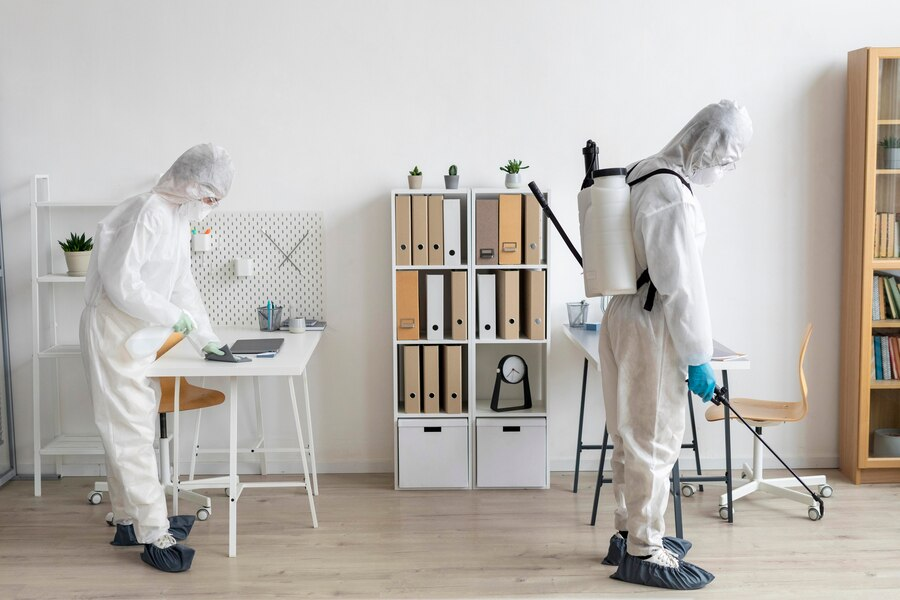When you schedule a professional pest control service, preparing your home ahead of time can make the treatment more effective and ensure the safety of your family and pets. Here’s a comprehensive checklist to help you get ready for pest control services, ensuring a smooth and successful process.

Content
1. Clear the Area
Remove Clutter: Clear any clutter from the areas where the pest control technicians will be working. This includes items on floors, countertops, and shelves. A clean and clutter-free environment allows the technicians to access all necessary areas and apply treatments effectively.
Move Furniture: Move furniture away from walls to give technicians easy access to baseboards, corners, and other key areas where pests may be hiding.
Example: If you’re having a treatment for bed bugs, ensure that beds, dressers, and nightstands are moved away from the walls and that bedding is removed and laundered.
2. Clean Your Home
Vacuum and Sweep: Thoroughly vacuum carpets, rugs, and furniture. Sweep and mop hard floors to remove food crumbs, dust, and other debris that can attract pests.
Take Out Trash: Empty all trash bins and dispose of garbage properly to eliminate food sources for pests.
Example: For a cockroach treatment, focus on cleaning the kitchen area, including behind appliances like the refrigerator and stove, where food particles can accumulate.
3. Protect Food and Utensils
Store Food Properly: Ensure that all food items are stored in sealed containers or placed in the refrigerator. This prevents contamination from pest control chemicals.
Cover Utensils: Cover or remove kitchen utensils, dishes, and food preparation equipment to protect them from exposure to pesticides.
Example: Use plastic wrap or airtight containers to cover food items on countertops and store dishes and utensils in closed cabinets.
4. Safeguard Pets
Remove Pets: If possible, arrange for pets to stay with a friend, family member, or pet boarding facility during the treatment. This ensures their safety and prevents exposure to chemicals.
Cover Aquariums: For fish tanks and aquariums, cover them securely with plastic wrap and turn off air pumps to prevent airborne chemicals from entering the water.
Example: If you have cats or dogs, ensure they are out of the house during the treatment and keep their food and water bowls covered or stored away.
5. Prepare the Outdoors
Mow the Lawn: If the pest control treatment includes the exterior of your home, mow the lawn and trim bushes to reduce hiding spots for pests.
Remove Debris: Clear away any outdoor clutter, such as leaves, woodpiles, and garden tools, to give technicians access to potential pest entry points.
Example: For termite treatments, remove any wood-to-soil contact around the foundation of your home, such as wooden planters or mulch.
6. Secure Personal Items
Remove Personal Items: Take personal items, such as clothing, toys, and electronics, away from areas to be treated. Store them in closets or rooms that will not be treated.
Protect Valuables: Cover or remove valuable items and sensitive materials, such as important documents and electronics, to prevent any potential damage.
Example: If your living room is being treated for ants, ensure that personal items like books, electronics, and children’s toys are stored safely in another room.
7. Communicate with the Technicians
Discuss Concerns: Talk to the pest control technicians about any specific concerns or areas of the home that you suspect may have pest activity. This ensures that no spots are overlooked.
Follow Instructions: Adhere to any pre-treatment instructions provided by the pest control company. This may include leaving the premises during the treatment or refraining from cleaning certain areas afterward.
Example: If you’re dealing with a rodent infestation, inform the technicians about any recent sightings or suspected entry points to focus their efforts effectively.
8. Plan for Post-Treatment
Wait for Safe Re-entry: Follow the pest control company’s guidelines on how long you should wait before re-entering your home after treatment. This ensures that any airborne chemicals have settled and it is safe to return.
Ventilate Your Home: After the treatment, open windows and doors to ventilate your home and clear out any residual chemicals.
Example: For general pest treatments, you may be advised to stay out of your home for a few hours and then ventilate the space upon returning.
Conclusion
Proper preparation for pest control services can significantly enhance the effectiveness of the treatment and ensure the safety of your household. By following this checklist, you can help create an environment that allows pest control technicians to do their job efficiently and effectively, leading to a pest-free home. Regular communication with your pest control provider and adherence to their recommendations will help maintain the results and keep your home protected from pests year-round.

My name is Dana Benally. I post about home improvement ideas and how to make your home look beautiful and liveable. I hope my posts will help you with your DIY projects!
